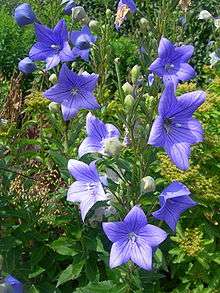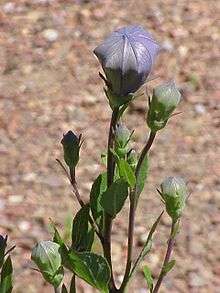Platycodon
| Chinese bellflower | |
|---|---|
 | |
| Scientific classification | |
| Kingdom: | Plantae |
| (unranked): | Angiosperms |
| (unranked): | Eudicots |
| (unranked): | Asterids |
| Order: | Asterales |
| Family: | Campanulaceae |
| Subfamily: | Campanuloideae |
| Genus: | Platycodon A.DC. |
| Species: | P. grandiflorus |
| Binomial name | |
| Platycodon grandiflorus (Jacq.) A.DC. | |
Platycodon grandiflorus (from Ancient Greek πλατύς "wide" and κώδων "bell") is a species of herbaceous flowering perennial plant of the family Campanulaceae, and the only member of the genus Platycodon. It is native to East Asia (China, Korea, Japan, and the Russian Far East).[1] It is commonly known as common balloon flower or balloon flower (referring to the balloon-shaped flower buds), and, depending on the region, Korean bellflower, Chinese bellflower, or Japanese bellflower.
Description

Growing to 60 cm (24 in) tall by 30 cm (12 in) wide, it is an herbaceous perennial with dark green leaves and blue flowers in late summer. A notable feature of the plant is the flower bud which swells like a balloon before fully opening.[2] The five petals are fused together into a bell shape at the base, like its relatives, the campanulas. There are varieties with white, pink and purple blooms in cultivation.[3] In Korea, white flowers are more common. This plant[4] together with its cultivars 'Apoyama group'[5] and 'Mariesii'[6] have gained the Royal Horticultural Society's Award of Garden Merit.
Uses

In Korea, the plant is known as doraji (도라지) and its root, either dried or fresh, is a popular ingredient in salads and traditional cuisine. The Chinese bellflower (called 桔梗 in Chinese) is also used in traditional Chinese medicine.
Medicinal properties
The extracts and purified platycoside compounds (saponins) from the roots of Platycodon grandiflorum may exhibit neuroprotective, antimicrobial, anti-inflammatory, anti-cancer, anti-allergy, improved insulin resistance, and cholesterol-lowering properties.[7] Evidence for these potential effects was mainly observed in vitro, with the exception of cholesterol lowering effects documented in vitro and in rats. The lack of efficacy and limited safety data in humans however, necessitates further research.
In Korea, the roots are commonly used for treating bronchitis, asthma, tuberculosis, diabetes, and other inflammatory diseases. In China, they are used as a cough suppressant and expectorant for common colds, cough, sore throat, tonsillitis, and chest congestion.[7]
In popular culture
In Japan
The bellflower is called kikyō (桔梗) in Japanese. Traditionally, it is one of the Seven Autumn Flowers. In addition, the "Bellflower Seal" (桔梗紋 kikyōmon) is the crest (kamon) of some clans.
 "Kikyō" is a plain Kikyōmon.
"Kikyō" is a plain Kikyōmon. "Toki Kikyō"is a variant used by the Toki clan, the Akechi clan, among others.
"Toki Kikyō"is a variant used by the Toki clan, the Akechi clan, among others. "Ōta Kikyō" is another variant used by the Ōta clan.
"Ōta Kikyō" is another variant used by the Ōta clan. "Seimei Kikyō" is a pentagram used by Abe no Seimei as the symbol of the Onmyoryo (Bureau of Taoist Geomancy) associated with the Five Chinese Elements.
"Seimei Kikyō" is a pentagram used by Abe no Seimei as the symbol of the Onmyoryo (Bureau of Taoist Geomancy) associated with the Five Chinese Elements.
In Korea
In Korea, the white bellflower (doraji) is sung about in the traditional folk song, "Doraji".
References
- ↑ "Platycodon grandiflorus". Flora of China. Missouri Botanical Garden – via eFloras.org.
- ↑ http://platycodon.net/
- ↑ RHS A-Z encyclopedia of garden plants. United Kingdom: Dorling Kindersley. 2008. p. 1136. ISBN 1405332964.
- ↑ "RHS Plant Selector - Platycodon grandiflorus". Retrieved 28 May 2013.
- ↑ "RHS Plant Selector - Platycodon grandiflorus 'Apoyama group'". Retrieved 28 May 2013.
- ↑ "RHS Plant Selector - Platycodon grandiflorus 'Mariesii'". Retrieved 28 May 2013.
- 1 2 Nyakudya E.; Jeong JH.; Lee NK.; Jeong YS. (2014) “Platycosides from the Roots of Platycodon grandiflorum and Their Health Benefits.” Preventative Nutrition and Food Science 19 (2): 59-68. PMID 25054103.
External links
| Wikimedia Commons has media related to Platycodon grandiflorus. |